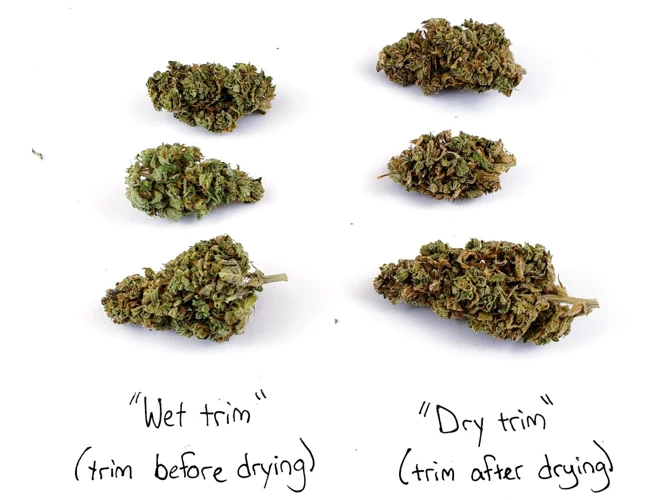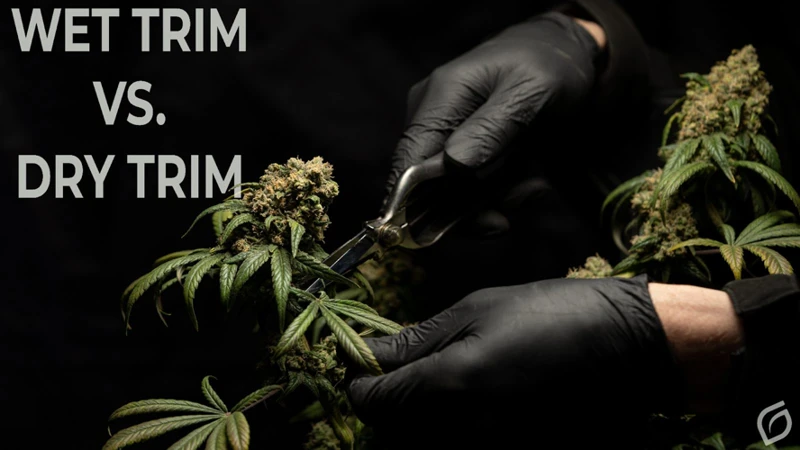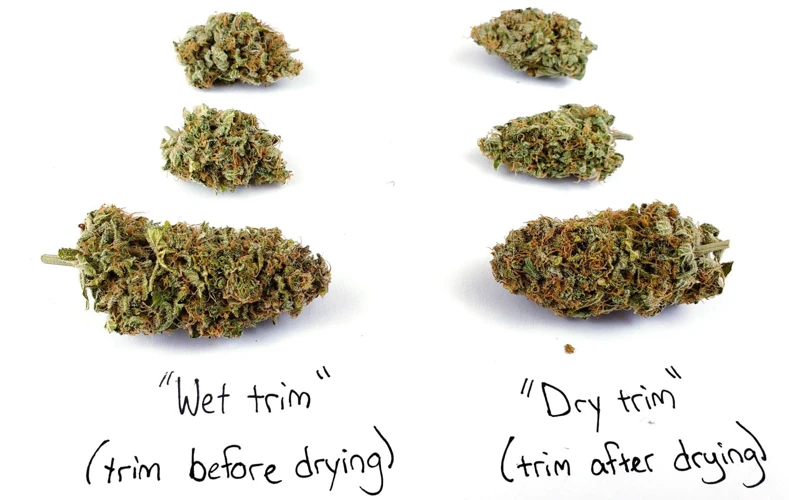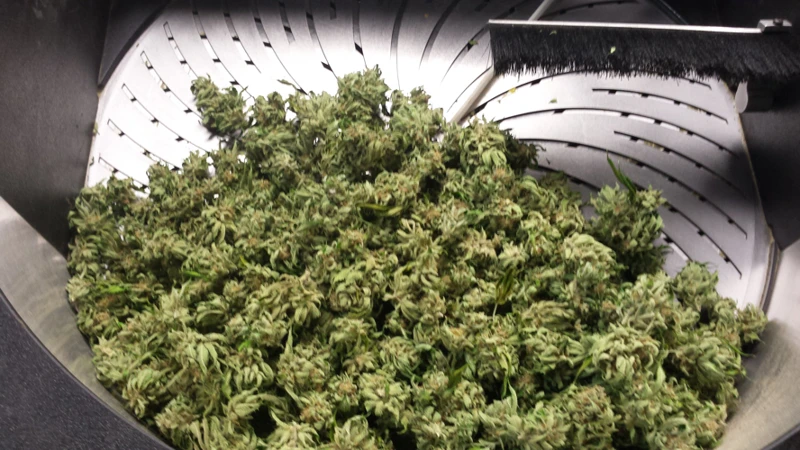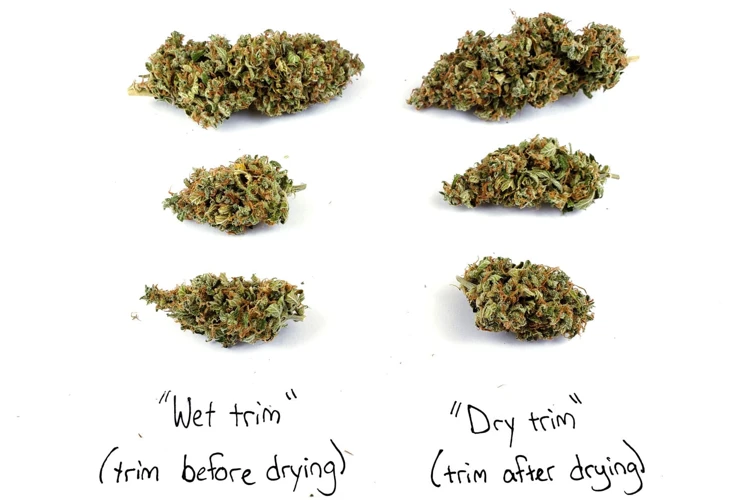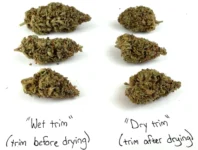
The Pros and Cons of Dry Trimming Vs Wet Trimming Your Cannabis Buds
As the cannabis industry continues to grow, so does the debate on whether to dry trim or wet trim cannabis buds. The choice between the two can be perplexing for growers, especially for beginners, as each method has its own set of advantages and disadvantages. Dry trimming involves trimming the buds after they have been harvested and dried, while wet trimming involves trimming the buds immediately after they have been harvested. So, which method is better? In this article, we will explore the pros and cons of both dry trimming and wet trimming, the tools required for each method, and the step-by-step process for both. We will also consider factors such as humidity levels, time constraints, and preference of appearance, and provide a comparison chart to help you make an informed decision on which method is best for you.
Dry Trimming
Contents
One dilemma that most cannabis growers face is whether to perform dry trimming or wet trimming on their harvested plants. While both methods have their own benefits and drawbacks, dry trimming is considered to be the traditional approach. However, what exactly is dry trimming and why is it preferred by some growers over the wet trimming method? Let’s dive into the intricacies of dry trimming and look at the pros and cons associated with it.
What is Dry Trimming?
Dry trimming is a technique used in cannabis harvesting where the plant is allowed to dry for a certain period before trimming. This methodology involves removing the larger leaves when the plant has dried out completely using a pair of scissors or a trimmer. Below are some important points to know about dry trimming:
- Drying: In dry trimming, the harvested buds are left to dry first before trimming. This process usually involves hanging them upside down on a line, in order to let the leaves and excess moisture dry out, which creates a better burning product.
- Remove Larger Leaves: Once the cannabis has reached the desired level of dryness, the larger fan leaves are removed, leaving only the smaller sugar leaves.
- Slower Process: Dry trimming is a slower process than wet trimming since it requires more time for the plant to dry out first.
- Less Sticky: When the cannabis is dry, it is less sticky, which can make the trimming process easier and faster.
- Better Flavor Profile: Dry trimming can also result in a better flavor profile since the plant has more time to break down complex sugars and starches during curing.
- Requires Attention: However, dry trimming can require more attention to detail since the dried leaves can easily break off and stick to the buds, potentially compromising the final product’s appearance.
Dry trimming is a beneficial technique for those who have the time and patience to achieve a beautiful end product. While it takes longer and requires more attention to detail, it can result in a superior flavor profile and an overall smoother smoking experience.
Advantages of Dry Trimming
Dry trimming your cannabis buds has several advantages over wet trimming. Let’s take a look at some of the most notable ones:
| Advantages of Dry Trimming: |
| – Prolongs shelf life: Dry trimming allows the buds to retain more of their natural moisture and oils, which can help to prolong their shelf life. |
| – Easier to handle: Dry buds are less sticky and easier to handle than wet buds. This can make the trimming process less messy and more efficient. |
| – Better for curing: Dry trimming is better for the curing process since it allows for more even drying and curing of the buds. |
| – Less risk of mold: Wet buds are more susceptible to mold and mildew growth, which can ruin your entire harvest. Dry trimming reduces this risk by removing excess moisture from the buds. |
| – Preserves trichomes: Trichomes, the small resin glands that produce cannabinoids and terpenes, are more likely to fall off when wet trimming. Dry trimming can help to preserve these trichomes, resulting in more potent buds with better flavor and aroma. |
Dry trimming has several advantages over wet trimming, particularly when it comes to preserving the quality of your buds and making the trimming process easier and more efficient. However, it’s important to keep in mind that dry trimming may not be the best option for everyone, and that certain factors such as humidity levels and time constraints can play a role in determining which trimming method is best for your specific needs.
Disadvantages of Dry Trimming
Dry trimming has a few disadvantages that may make it less appealing than wet trimming for some cannabis growers. Some of the main disadvantages of dry trimming include:
- Increased Difficulty: Dry trimming can be more difficult than wet trimming because the leaves are dry and brittle, making them harder to cut without damaging the surrounding buds. This can be especially challenging for growers who are new to the process and may not have the necessary experience or tools.
- Increased Processing Time: Because dry trimming requires a longer curing period, it can take longer to process and prepare buds for consumption. This can be problematic for growers who need to get their products to market quickly or who are working on a tight timeline.
- Potential for Loss of Terpenes: Dry trimming can sometimes result in a loss of terpenes, which are the aromatic compounds that contribute to the flavor and aroma of cannabis. This is because the terpenes can evaporate or degrade during the drying process, which can affect the overall quality of the final product.
- Potential for Increased Harshness or Clipping: Dry trimming can sometimes result in harsh or clipped buds, which can be unpleasant to smoke or consume. This can be especially problematic for growers who are trying to produce a high-quality product and who may be negatively impacted by negative reviews or feedback from consumers.
- Inconsistent Results: Because dry trimming can be more difficult than wet trimming, it can be difficult to get consistent results with this method. This can be frustrating for growers who are trying to achieve a specific flavor or aroma profile, and who may not be able to achieve their desired results with consistency.
While there are definitely some downsides to dry trimming, it’s important to keep in mind that every grower’s situation is unique. Depending on your specific goals and circumstances, dry trimming may be the better option for you.
Wet Trimming
When it comes to harvesting your cannabis buds, one of the choices you will have to make is whether to dry trim or wet trim them. While dry trimming involves waiting until the buds are completely dry before trimming the leaves, wet trimming involves removing the leaves while they are still wet from the plant. Wet trimming can be a bit more daunting for beginners, but it also comes with its own advantages and disadvantages that are worth exploring. So let’s dive into the details of wet trimming your cannabis buds.
What is Wet Trimming?
Wet trimming is the process of removing the excess leaves from cannabis buds immediately after harvesting, while the plant is still fresh and wet. This method involves manicuring the buds before they are cured or dried. This process can be done by hand or machine, and is usually done prior to drying the buds.
The following table summarizes the main characteristics of wet trimming:
| Characteristics | Description |
| Timing | Performed immediately after harvesting |
| State of the buds | Fresh and wet |
| Tools Required | Scissors or trimming machine |
| Process | Manicuring buds by removing excess leaves |
| Advantages | Less sticky and time-consuming, retains more natural color and aroma, easier to handle and package |
| Disadvantages | Buds can dry out faster, may have a lower yield and potency, increased risk of mold or mildew due to excess moisture |
Wet trimming is generally preferred by commercial growers or those with limited time constraints as it can decrease the time needed for post-harvest processing. However, it is worth noting that wet trimming does come with its own disadvantages. For example, wet trimmed buds can dry out faster due to the excess moisture, and the buds may have a lower yield and potency compared to buds that have been dry trimmed. Additionally, the increased risk of mold or mildew can be a concern, as the excess moisture can create an ideal environment for these unwanted fungi to grow.
Advantages of Wet Trimming
Wet trimming your cannabis buds has several advantages over dry trimming. Here are some of the main benefits of wet trimming:
| Advantages of Wet Trimming |
|---|
| 1. Easier to handle – Wet cannabis buds are easier to handle and manipulate than dry ones. The leaves are still pliable and soft, making it easier to trim them neatly. |
| 2. Less delicate – Wet buds are less delicate than dry ones, so you’re less likely to damage them during the trimming process. |
| 3. Less resin loss – Wet trimming can help reduce the amount of resin loss. As the leaves are still moist, they’re less likely to get damaged, which means less resin will be lost during the trimming process. |
| 4. Faster – Wet trimming is generally faster than dry trimming, as the leaves are easier to cut through and the buds are easier to handle. |
| 5. Better aroma – Wet trimming can help to preserve the aroma of the buds better, as the moisture in the leaves helps to lock in the fragrance. |
| 6. Can improve appearance – Wet trimming can also improve the appearance of the buds. The leaves can be trimmed closer to the bud, which can make the bud appear neater and more professional. |
Wet trimming can be a better option if you’re looking for a quicker and easier trimming process, with less risk of damaging your buds. However, it’s important to keep in mind that wet trimming may not be suitable for all strains, and may not produce the same flavor or texture as dry trimming. Ultimately, the choice between wet and dry trimming will depend on your personal preference and the specific needs of your cannabis crop.
Disadvantages of Wet Trimming
Wet trimming is not without its drawbacks, and it’s important to weigh these against the advantages before deciding which trimming method to use. Here are the disadvantages of wet trimming:
| Disadvantages of Wet Trimming |
| 1. Loss of potency |
| 2. Difficulty in handling wet plants |
| 3. Increased risk of mold and mildew |
| 4. Time-consuming process |
Loss of potency: Wet trimming can lead to a loss of potency due to the loss of resin glands and trichomes during the trimming process. These are the parts of the plant that contain the highest levels of THC and other cannabinoids, and you don’t want to lose them unnecessarily.
Difficulty in handling wet plants: Wet plants are difficult to handle and transport, especially if you have to move them to a different location for trimming. Wet leaves and buds are more prone to damage and bruising, which can further reduce their potency and overall quality.
Increased risk of mold and mildew: Wet trimming can also increase the risk of mold and mildew formation on the buds. When you trim wet plants, you create a lot of excess moisture, and if you don’t dry them properly and thoroughly, mold and mildew can develop and ruin your entire crop.
Time-consuming process: Wet trimming is an extremely time-consuming process, especially if you have a large crop. It can take hours and sometimes even days to trim wet plants, and you need to pay close attention to every bud and leaf to make sure you don’t miss anything. This can be exhausting and stressful, especially if you’re on a tight schedule.
Factors to Consider
When deciding between dry trimming and wet trimming your cannabis buds, there are several factors to consider. These factors include the humidity levels of your drying environment, any time constraints you may have, and your preference for the final appearance of your buds. Each trimming method has its own advantages and disadvantages, so it’s important to carefully weigh these factors before making your decision. In this article, we’ll take a closer look at each of these factors and how they can impact your choice of trimming method.
Humidity Levels
One of the most crucial factors to consider when deciding whether to dry trim or wet trim your cannabis buds is the humidity levels of your drying location. Humidity levels can have a significant impact on the overall quality and potency of your buds.
If you live in a high humidity area, dry trimming may be the better option for you. High humidity levels can increase the risk of mold and mildew growth on wet trimmed buds during the drying process. Dry trimming enables you to remove the large fan leaves that can trap moisture and create a suitable environment for mold growth.
On the other hand, wet trimming may be a better choice if you live in a low humidity area. Low humidity levels can cause buds to dry out too quickly, leading to a harsh, unpleasant smoke. Wet trimming can help slow down the drying process by leaving more foliage on the buds, which retains more moisture.
It’s important to monitor the humidity levels of your drying location regardless of which method you choose. Using a hygrometer to measure the relative humidity can help ensure that your buds are drying at the optimal humidity range of 45-55%. If the humidity levels are too high, you may need to use a dehumidifier or increase airflow in the drying area. If the humidity levels are too low, you may need to increase the number of plants being dried, use a humidifier or add a moist cloth to the drying area.
Time Constraints
One of the factors to consider when deciding between dry trimming and wet trimming your cannabis buds is time constraints. Each method has its own specific timeline, and it is important to take into account the amount of time you have available to dedicate to trimming.
Dry trimming can take longer than wet trimming as it requires waiting for the buds to dry completely before trimming. This can take anywhere from 7-14 days depending on the humidity levels in your drying environment. Once the buds are sufficiently dry, you can begin the trimming process which can take several hours to complete depending on the amount of buds you have.
On the other hand, wet trimming can be done immediately after harvesting your buds. This can save time as you do not have to wait for the buds to dry. The entire process of wet trimming can take anywhere from 1-3 hours depending on the amount of buds you have.
To better understand the time differences between the two methods, refer to the table below:
| Dry Trimming | Wet Trimming | |
|---|---|---|
| Time to Wait Before Trimming | 7-14 days | Immediate |
| Time to Trim | Several hours | 1-3 hours |
It is important to keep in mind that time constraints may also depend on the size of your operation. If you have a small amount of buds to trim, wet trimming may be a quicker option. However, if you have a larger amount of buds to trim, dry trimming may be more efficient in the long run as you can trim larger quantities at once. Ultimately, the decision to dry trim or wet trim will depend on your individual time constraints and preferences.
Preference of Appearance
When it comes to the appearance of the final product, preference plays a significant role in deciding whether to go for dry trimming or wet trimming. This is because both techniques produce buds with different visual characteristics.
For those who prefer a more natural look for their cannabis, dry trimming is a great option. Since this method allows the buds to retain their original shape and size, they tend to look less manicured and more rustic. Dry trimmed buds have a wilder, more organic appearance compared to those that undergo wet trimming.
On the other hand, wet trimming produces a more polished look for buds. This is because wet trimming removes most of the sugar leaves and other excess foliage that surround the buds. As a result, the buds tend to look more streamlined and neat, with a greater density of trichomes. Wet trimming yields buds with a cleaner, more commercial look compared to dry trimmed buds.
Ultimately, the choice between dry trimming and wet trimming comes down to personal preference when it comes to the appearance of the final product. Here’s a quick summary of the visual differences between the two techniques:
| Dry Trimming | Wet Trimming | |
|---|---|---|
| Appearance | Wild, rustic, and organic | Streamlined, neat, and commercial |
| Density of Trichomes | Medium | High |
| Shape and Size of Buds | Retains original shape and size | May be trimmed down to a smaller size |
How to Dry Trim Your Cannabis Buds
If you have decided to dry trim your cannabis buds, it’s time to gear up and learn the process. Though it may seem daunting at first, with the right tools and techniques, you can get quality results that will make it worth your while. In this section, we will provide you with a step-by-step guide on how to get started with dry trimming your cannabis buds. So, grab your gloves, trimming scissors, and a few other essential tools, and let’s dive in!
Tools Required
When it comes to trimming your cannabis buds, there are specific sets of tools that you will need depending on whether you choose to dry trim or wet trim. For both methods, you will want to make sure you have a clean and clear workspace.
Dry Trimming Tools:
- Sharp Scissors: You will want a pair of scissors that are sharp and easy to handle. Many cannabis growers prefer small pruning scissors, as they offer precision cuts.
- Trimming Tray: A tray or surface to catch any excess leaves or buds will make the clean-up process much more manageable.
- Gloves: Wearing gloves (such as latex or nitrile) can help prevent any transfer of dirt, oil, or other contaminants from your hands to the buds.
- Magnifying Glass: A magnifying glass can help you see small details on your buds and ensure you are making precise cuts.
- Bud Containers: You will want airtight containers to store your trimmed buds in.
Wet Trimming Tools:
- Pruning Shears: You will want to use pruning shears for wet trimming, as they can cut through larger leaves and stems.
- Cutting Board: Use a cutting board to hold the plant while you trim it.
- Gloves: Wear gloves to avoid contaminating the buds.
- Bucket of Water: Keep a bucket of water nearby to rinse your pruning shears and hands.
- Drying Rack: A drying rack is necessary to dry your buds after wet trimming.
Having the right tools for the job will help make the trimming process more comfortable and efficient. Additionally, storing your tools in a clean and organized space will help ensure they remain in good condition for future use.
Step-by-Step Process
To dry trim your cannabis buds, follow these steps:
| Step | Action |
|---|---|
| Step 1 | Harvest the mature cannabis plants, leaving as much stem as possible. |
| Step 2 | Hang the plants upside down in a dark, cool, and dry room with proper ventilation. |
| Step 3 | Let the plants cure for several days to a few weeks until they become slightly crunchy on the outside, but still slightly moist. |
| Step 4 | Use a pair of trimming scissors to remove the fan leaves and sugar leaves surrounding the buds. |
| Step 5 | Use a gentle touch and the trimming scissors to trim away any remaining leaves or stems, leaving only the buds. |
| Step 6 | Place the trimmed buds in a jar to continue curing until they reach the desired moisture level. |
On the other hand, wet trimming involves trimming the cannabis buds right after they have been harvested and while they are still wet. The following steps will guide you on how to wet trim your cannabis buds:
| Step | Action |
|---|---|
| Step 1 | Harvest the mature cannabis plants. |
| Step 2 | Remove the fan leaves surrounding the buds. |
| Step 3 | Use a pair of trimming scissors to cut away any remaining sugar leaves or stems from the buds. |
| Step 4 | Place the trimmed buds on a drying rack in a dark, cool, and dry room with proper ventilation. |
| Step 5 | Turn the buds over regularly during the drying process to ensure they dry evenly. |
| Step 6 | Continue curing the dried buds in a jar until they reach the desired moisture level. |
Both dry and wet trimming methods require using trimming scissors to carefully remove excess leaves and stems from the buds. However, it is important to note that wet trimming requires more precision as the buds are still wet and delicate, whereas dry trimming allows for a more forgiving trimming process since the buds are already dried out.
How to Wet Trim Your Cannabis Buds
Preparing your cannabis buds for consumption begins with proper trimming. Wet trimming refers to the process of trimming the buds while they are still moist after being harvested, and can result in a more appealing appearance. It’s important to note that wet trimming can be a more time-consuming process than dry trimming, but can also offer some unique advantages. In this section, we will discuss the tools required for wet trimming and provide a step-by-step process for optimal results.
Tools Required
When it comes to trimming cannabis buds, you will need different tools depending on whether you choose to do a dry trim or a wet trim. Here is a list of tools commonly used for each method:
Tools required for Dry Trimming:
- Trimming scissors
- Gloves
- Trays or bins for catching trimmings
- Shears for larger stems and leaves
- Drying racks or hanging lines
- Magnifying glass or jeweler’s loupe
Tools required for Wet Trimming:
- Trimming scissors
- Gloves
- Buckets or containers for water
- Trays or bins for catching trimmings
- Shears for larger stems and leaves
- Drying racks or hanging lines
- Fans for adequate air circulation
It is important to have a clean and organized workspace when trimming cannabis, regardless of the method you choose. Make sure all of your tools are clean and sharp to avoid damaging the buds. Using gloves can also help prevent contamination from oils and bacteria on your hands.
Step-by-Step Process
Here is a step-by-step process on how to trim your cannabis buds using the dry trimming method:
- Step 1: Before anything else, make sure that your buds are completely dry. This is important because if your buds are moist or wet, they can easily become damaged during the trimming process.
- Step 2: Set up your work area. You’ll need a clean, dry surface to work on, as well as a pair of clean, sharp scissors or pruning shears.
- Step 3: Take a bud and hold it by the stem. Use your scissors to snip off any excess leaves or stems from around the bud. Be careful not to cut too close to the bud, as this can damage it.
- Step 4: Look closely at the bud to see if there are any remaining leaves or stems that need to be trimmed. Use your scissors to carefully snip away any remaining excess material. Again, be careful not to damage the bud.
- Step 5: Repeat steps 3 and 4 for each bud until all of them have been trimmed.
- Step 6: Once you’ve finished trimming all of your buds, inspect them closely to make sure that there aren’t any remaining leaves or stems. If you notice any, go back and trim them off carefully.
Remember that dry trimming takes longer than wet trimming, but it can result in a higher quality end product. Take your time and be patient during this process to ensure that your buds are trimmed properly.
Comparison Chart
When deciding between dry trimming and wet trimming for your cannabis buds, it’s important to understand the key differences and benefits of each method. Here’s a comparison chart to help you make an informed decision:
Dry Trimming | Wet Trimming
———————————— | ————————————
Usually done after buds are dried and cured | Usually done before buds are dried and cured
Leaves are easier to remove and collect | Leaves are more difficult to remove and collect
Preserves the natural aroma and flavor of the buds | Can diminish the aroma and flavor of the buds
May result in a slower trimming process | Typically results in a faster trimming process
Less sticky and easier to handle | More sticky and can be difficult to handle
Best option for outdoor-grown buds | Best option for indoor-grown buds
As the chart shows, there are definite pros and cons to both dry trimming and wet trimming. Dry trimming is generally preferred for its ability to preserve the natural aroma and flavor of the buds, as well as the ease of collecting the leaves. Wet trimming, on the other hand, is typically faster and more efficient, but can result in a loss of aroma and flavor. It’s also worth considering the type of bud you’re trimming, as outdoor-grown buds may be better suited for dry trimming while indoor-grown buds may benefit from wet trimming.
Ultimately, the decision between dry trimming and wet trimming will depend on a variety of factors, including your personal preference, the time constraints you’re working with, and the humidity levels of your environment. It’s important to weigh the pros and cons carefully and choose the method that’s best for your unique situation.
Which One is Better?
When it comes to deciding whether dry trimming or wet trimming is better, it ultimately boils down to personal preference and specific circumstances. There are advantages and disadvantages to both methods, and determining which one to use can depend on factors such as humidity levels, time constraints, and preference of appearance.
Dry trimming requires patience and attention to detail, as it involves trimming the cannabis buds after they have been dried. The advantage of dry trimming is that it can allow for a slower and more controlled drying process, which can help preserve the terpene content and overall flavor of the cannabis. Additionally, dry trimming can make it easier to trim the buds, as they will have a more defined shape and structure.
However, dry trimming can also be more time-consuming and labor-intensive, as the buds must be carefully handled to avoid damaging them. Additionally, dry trimming can create more plant matter, such as leaves and stems, which may need to be separated from the buds before consumption.
Wet trimming, on the other hand, involves trimming the cannabis buds immediately after they have been harvested and still contain moisture. This method can be faster and more efficient, as the leaves are easier to trim while they are still moist.
The advantage of wet trimming is that it can result in a more visually appealing end product, with buds that have a cleaner and more manicured appearance. However, wet trimming can also increase the risk of mold and other contaminants, as the moisture can create a breeding ground for bacteria and fungi.
Ultimately, the decision of whether to dry trim or wet trim will depend on the specific circumstances and priorities of the grower. Factors such as humidity levels, time constraints, and preference of appearance should all be taken into consideration when making this decision.
To help with this decision, a comparison chart can be created, outlining the pros and cons of each method. This chart can include factors such as time required for trimming, risk of mold and contamination, and overall appearance of the end product.
Both dry trimming and wet trimming can be effective methods for trimming cannabis buds. The decision of which one to use will ultimately depend on individual circumstances, and growers should take the time to carefully consider their options before making a choice.
Conclusion
In conclusion, the decision to dry trim or wet trim your cannabis buds ultimately depends on your personal preferences and specific circumstances. Both methods have their own set of advantages and disadvantages.
Dry trimming is the traditional method that involves waiting for the buds to dry before trimming off the leaves. This method has the advantage of preserving the aroma and flavor of the buds, as well as making them easier to handle during the trimming process. However, dry trimming requires more time and effort, as the buds need to be regularly monitored and rotated during the drying process.
Wet trimming, on the other hand, involves trimming the leaves off the buds immediately after harvesting. This method is faster and more efficient, as the leaves are easier to trim while they are still moist. Wet trimming also tends to result in a more manicured appearance of the buds, which may be desirable for some growers. However, wet trimming can negatively impact the flavor and aroma of the buds, as the moisture content can lead to mold and mildew if not properly managed.
When deciding which method to use, it is important to consider factors such as humidity levels, time constraints, and personal preference of appearance. Both methods require specific tools and a step-by-step process to be followed for the best results.
In conclusion, there is no one-size-fits-all answer to the question of dry trimming versus wet trimming. The choice ultimately comes down to what works best for you and your specific situation. With proper care and attention, either method can result in high-quality cannabis buds that are sure to satisfy.
Frequently Asked Questions
What is the difference between dry trimming and wet trimming?
Dry trimming involves trimming the leaves from the cannabis buds after they have been dried, whereas wet trimming involves trimming the leaves from the buds before they have been dried.
Which trimming method is better for preserving the flavor of the buds?
Dry trimming is generally considered better for preserving the flavor of the buds, as wet trimming can remove more of the trichomes that contain the cannabis oil responsible for the flavor.
Which trimming method is faster?
Wet trimming is generally faster, as the leaves are easier to trim when they are still moist and pliable.
Can wet trimming affect the potency of the buds?
There is some evidence to suggest that wet trimming can reduce the potency of the buds, as more trichomes may be lost in the trimming process.
What effect does humidity have on trimming?
High humidity can make it more difficult to dry trim the buds, as the leaves may become sticky and difficult to handle. Low humidity can make it more difficult to wet trim the buds, as the leaves may become brittle and break off easily.
What tools do I need for dry trimming?
You will need sharp trimming scissors, a large tray for the buds, and a pair of gloves to protect your hands from the resin.
What tools do I need for wet trimming?
You will need sharp trimming scissors, a large tray for the buds, and a pair of gloves to protect your hands from the resin. You may also want to use a small fan to dry the buds more quickly after trimming.
Can I dry trim my buds if they are still wet?
No, you should always wait until the buds are dry before trimming them, as wet trimming can remove too much of the resin and reduce the potency of the buds.
What is the best way to store trimmed buds?
Trimmed buds should be stored in a dry, airtight container such as a Mason jar. Keep the container in a cool, dark place to preserve the potency and flavor of the buds.
Which trimming method should I use?
The choice of trimming method will depend on your personal preference, the time you have available, and the humidity levels in your area. Consider both the advantages and disadvantages of each method before making a decision.

